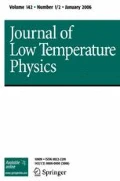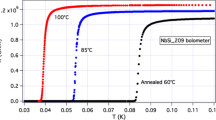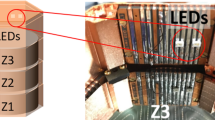Abstract
This paper describes the methodology and results from a dedicated study of the heat signals as observed by the EDELWEISS FID800 (Full Interdigit Detector) Ge bolometers. We show how, with a combined set of measurements, we constructed a coherent thermal model and extracted the relevant heat capacities and thermal conductances at play in our detectors, as well as the origin of the heat signal. Eventually, we show that our heat energy resolution could potentially be improved by a factor of five leading to nuclear recoil energy thresholds ranging from 400 to 100 eVnr, depending on the applied voltage across the crystal, which would provide great sensitivity to low-mass dark matter down to 0.5 GeV.




Similar content being viewed by others
Notes
\(C_{x}\) has first been added to our model as it provides a consistent description of our data but its origin still has to be determined
References
A. Juillard for the EDELWEISS coll., J. Low Temp. Phys. This Special Issue. doi:10.1007/s10909-016-1493-0
Q. Arnaud et al., EDELWEISS coll., J. Low Temp. Phys. This Special Issue. doi:10.1007/s10909-015-1463-y
D. L’Hôte et al., J. Appl. Phys. 87, 3 (2000)
K.D. Irwin, G.C. Hilton, Transition-edge sensor, in Cryogenic particle detection, vol. 3, ed. by C. Enss (Springer, Berlin, 2005), pp. 63–149
M. Pyle et al., Optimized design for very low temperature massive calorimeters. arXiv:1503.01200v2
M. Piat et al., J. Low Temp. Phys. 125, 5 (2001)
M. Pedretti, The single module for Cuoricino and CUORE detectors: test, construction and modelling, PhD thesis, Università degli Studi dell’Insubria, 2004
M. Lindeman, Microcalorimetry and the transition-edge sensor, Ph.D. thesis, University of California at Davis, 2000
A.J. Anderson, Ring detector thermal model and optimization, Ph.D. thesis, MIT, 2014
Acknowledgments
The help of the technical staff of the Laboratoire Souterrain de Modane and the participant laboratories is gratefully acknowledged. The EDELWEISS project was supported in part by the German ministry of science and education (BMBF Verbundforschung ATP Pro j.-Nr. 05A14VKA), by the Helmholtz Alliance for Astroparticle Physics (HAP), by the French Agence Nationale pour la Recherche and the Labex Lyon Institute of Origins (ANR-10-LABX-0066) of the Université de Lyon within the program Investissement d’Avenir (ANR-11-IDEX-00007), and by Science and Technology Facilities Council (UK) and the Russian Foundation for Basic Research (Grant No. 07-02-00355-a).
Author information
Authors and Affiliations
Corresponding author
Additional information
The EDELWEISS Collaboration.
Rights and permissions
About this article
Cite this article
Billard, J., De Jesus, M., Juillard, A. et al. Characterization and Optimization of EDELWEISS-III FID800 Heat Signals. J Low Temp Phys 184, 299–307 (2016). https://doi.org/10.1007/s10909-016-1500-5
Received:
Accepted:
Published:
Issue Date:
DOI: https://doi.org/10.1007/s10909-016-1500-5




